
Hexagon Towers
Designer:
jonifide5
Project Category:
Tower Speakers
Project Level:
Intermediate
Project Time:
8-20 Hours
Project Cost:
$100 – $500
Project Description:
I wanted to use up some left-over walnut hardwood, and find a home for some drivers I’ve been experimenting with. I designed some hexagon towers, with two modules per speaker. The base module is vented with an up-firing woofer, and the top module has three 3-inch full range drivers in a sealed enclosure (high pass around 150Hz). I use MiniDSP 2×4 (Part # 230-320) for an active crossover, and a Sure 4×100 amp module (Part # 320-335) to drive the speakers. all parts purchased from Parts Express (except wood and the steel tubing that supports the top modules).
Design Goals:
My goal was to build attractive speakers for my daughter & son-in -law using affordable drivers & some walnut scraps I had left over from another speaker project. Low end needed to have some muscle. Most importantly…my daughter’s needed to love them.
Driver Selection:
I chose the Tang Band W5-1138SMF 5.25-inch woofer (Part # 264-917) for the low end, because I’ve used them in other projects, they’re inexpensive and produce sweet sounding bass (for vented enclosure). I recently bought a variety of small full range drivers for experimenting, and the Dayton PC83-8 3-inch drivers (Part # 295-156) matched well when modeled with the TB W5’s.
Ultimately…I used what I had on hand.
Enclosure Design:
The W5’s produce surprisingly low bass in small enclosures…but they need long ports to do it. My daughter wanted a small footprint, so the vertical port was one of the driving elements in design. My wood scraps were limited in width, so hexagon towers allowed narrow sides (4-inches wide). The only way to fit the 6.2-inch W5 diameter onto the hexagon module was to have it up-firing or down-firing. I thought a parabolic reflector (turned on a lathe) would be attractive…so up-firing style won over. The triangle base adds stability and the Dayton Spikes (Part # 240-678) provide an air gap for the port.
For the top module containing the PC83’s, I decided on 3-drivers, with the outer two wired in series, and then wired in parallel to the center driver. This facilitates higher SPL’s without much combing (ears are fooled by louder center driver).
Enclosure Assembly:
Top and bottom hexagon module sides are 1/2-inch (1/4-inch walnut glued to 1/4-inch MDF). Each module contains horizontal braces, and the Port is fixed to work as additional vertical bracing in the woofer module.
The tops, bottoms and base required joining scraps, so I used figured maple scraps at all joints.
The parabolic reflectors were pieced together from scraps, and then turned on a lathe. the finished reflectors were glued into recessed openings in the bottom of each top module.
Finally, top and bottom modules were linked using 6 sections of 1/4″ steel tubing (tubing allows wires to be fed to the top modules).
Crossover Design:
Using MiniDSP 2×4 (Part # 230-320) for an active crossover. Using DAT v2 (Part # 390-806) for driver testing, and REW freeware for room equalization.
Tips & Tricks:
be careful:-)
Conclusion:
Imaging is great when seated in the movie watching position. Music and movie listening goals are achieved. I tested in a large room (25-ft x 45 ft, and sound quality is good in most areas of the room, with imaging sacrificed when more than 30-degrees off axis, or standing close/above the enclosures. I haven’t used REW to tune the room, because these will live in my daughter’s home (out-of-state). Instruments are detailed at low and high volumes. No sub woofer needed here…bass is strong, tight and ‘felt’ without straining the TB W-5’s.
About the Designer:
I’m a math-geek. My woodworking projects are usually focused on turning polyhedra into spheres (lathe). I’ve been building speakers for the past 30-years…but I usually go to Rick Craig (Selah Audio) for the designs, and I just focus on the wood working. This is the first design ‘all on my own’, and I probably wouldn’t have attempted it without the MiniDSP technology.
Project Parts List:
|
Part # |
Description |
Qty |
|
230-320 |
miniDSP 2×4 Digital Signal Processor |
1 |
|
264-917 |
Tang Band W5-1138SMF 5-1/4″ Paper Cone Subwoofer Speaker |
2 |
|
295-156 |
Dayton Audio PC83-8 3″ Full-Range Poly Cone Driver |
6 |
|
240-678 |
Dayton Audio DSS3-SN Satin Nickel Speaker Spike Set 4 Pcs. |
2 |
|
091-1247 |
Dayton Audio BPA-38SN HD Binding Post Pair Satin Nickel |
4 |
|
320-335 |
Sure Electronics AA-AB33182 4x100W at 4 Ohm Class D Digital Audio Amplifier Board STA508 (TK2050) |
1 |
|
320-3152 |
Mean Well MW SE-600-24 24 VDC 25A 600W Regulated Power Supply |
1 |
|
081-435 |
Parts Express #6 x 3/4″ Deep Thread Pan Head Screws Black 100 Pcs. |
1 |
|
N/A |
Steel tubing |
1 |
|
N/A |
Hardwood (Walnut and Maple) |
1 |
|
N/A |
MDF |
1 |

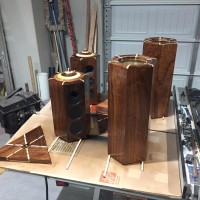
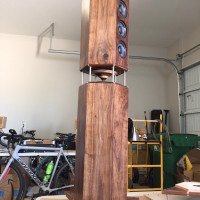
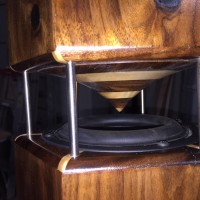
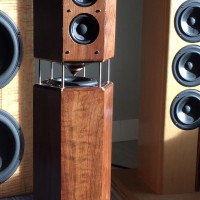
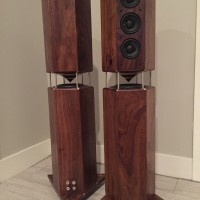
I love these. I am wondering how do you glue this up and clamp it? I have been trying to biscuit something on an angle, but haven’t come up with a good means for clamping it or holding it in place?
All the internal braces and the tops/bottoms are fit into dadoes on the inside of the hexagonal side panels. The side panels & internal braces for each module are glued up all at once (top & bottom pieces are installed later), with the braces/dadoes holding everything in alignment, and blue painters tape on the outside for keeping the vertical joints tight (no clamps). After the glue dries (24-hours), the top & bottom pieces were glued & clamped into place (also fit with dadoes).
I wish I had a pair like these in my house. Nice job !!!
How big are these speakers? i noticed the 3 top drivers are not that big and you told the sides where arround 10 cm so if my metric school does not fail me the should be arround 12 liters inside ( i guess the top ones are arround 30 cm high 🙂
Anyway I realy love those and I hope your daughter love them too
Best dad ever !
Very attractive and creative speakers! Well done!!!
Question: You stated the reflectors are parabolic. Out of curiosity, what are the quadratic terms of the equation used determine the curvature of the reflector/lens? Why did you choose a parabola configuration over a natural log, or Golden Section such as found in brass horns (trombones, trumpets, tubas, etc.)? Is there an advantage of a parabolic over Golden Section or natural log e? The reason I am asking is that I have a similar (but octagonal) speaker configuration with an upward firing sub, and am laminating the material now for the two reflectors/lens and still unsure of the needed curve for uniform reflection of the lower registers.
Thank you,
David Hall
Regarding the parabolic reflectors…with a crossover point below 200hz & small diameter reflectors, the wavelength is too large for the reflectors to have an audible impact. The design went through many changes, and my original plan had different drivers and a much higher crossover point. This final design functions less like a 2-way, and more like sattelites with 2-subs. I could have eliminated the reflectors, but my aesthetics advisor (wife) insisted they stay. They look cool, but don’t really change the sound to any audible/noticeable degree. You busted me:-(
No worries. Like you, nonetheless, I too will include them for aesthetic reason if for no other reason than to have a reason to play with my lathe. 😉
so cool. So, how about the sound….
I wished you provided building plans… I realy love these and I like to build them too
You have done an extraordinary job!
Sorry for the second post…
Perhaps if building plans are not an option
Can you give use mesurement of height width ans so on of the cabinets.? Please..?
Many thanx